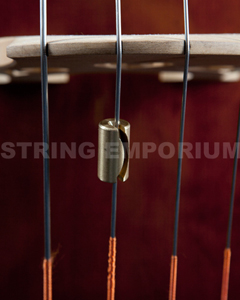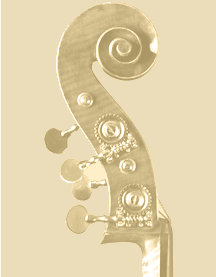Bass Wolf and "Eliminators"Even the best,
most expensive upright basses, can have a "wolf" tone somewhere on
it. Sometimes what is first recognized as a rattle or buzz on
the fingerboard is actually a wolf note. They should really
call wolf eliminators....wolf movers.

The quick and easy explanation of a wolf note is that the body of
your bass, itself alone (even without any strings on it), has a
vibrating pitch or frequency to it. If you lightly tap on the
back, you can hear a pitch. (Just don't tell my percussionist
friends I admitted that!!). Anything that vibrates, anything
that makes a noise...has a pitch. One never knows where or
what the 'body' pitch is going to be or how strong it is.
Let's say for example that the natural vibrating pitch of your bass
body is some kind of low "A". When I write "some kind" I
mean, that the "A" is not perfectly in tune. So now, when you
tune your bass perfectly to A440, you might get a little resistance
with the the bass body's "close" bass pitch "A". The best way
to understand this is to first perfectly tune your bass up, then
find the A on your E string....now, slide just a tad bit up or down
and then play that along with your open A string!! You can
feel that "wolf" or those two pitches fight with slight different
vibrating wavelengths that bang into each other. This is much
easier to hear and feel using a bow. Maybe the "wolf"
connotation is meant for violins that are higher in pitch. I
never hear any "howling", but I get plenty of resistance to that
pitch. You can feel it.
A wolf note comes in different disguises. Sometimes subtle and
sometimes rude, here are some indications: A certain note
might feel like a buzz or clack on the fingerboard (while plucking
or walking a bass line.) Oddly enough it could happen on the
same pitch, on 2 or 3 strings! What are the odds that you have
a low or high spot (on your fingerboard) with the the same pitch, on
different strings??? Great odds! It must be a wolf.
The string doesn't want to vibrate freely on that spot.
Sometimes, you may be playing (bowing) this big "juicy" passage only
to have one particular note pop out or resist vibrating the same as
the notes do before and after it....yes, you guessed it, a wolf!
A wolf isn't the kiss of death, it just is. You
learn how to play with it, on it and move it around so that it
doesn't stand out as much or at all. Again, even the most
expensive (million dollar) Strads can have one of these and usually,
it's no biggie.
Again, it's natural, and EVERY upright bass has a natural frequency
vibration. Some are just more noticeable. What
to do and how to deal with it:
Sometimes it's all about set up. If your bass hasn't been tweaked in
a long time the post can be too short or too long. It can be
in the "wrong" place too. Just one millimeter can make a world
of difference. You never know, until you try it. Even
seasonal changes will move or change that note. Especially on
old, expensive Italian basses!
Also, adding a wolf eliminator between the tailpiece and bridge, can
change that very same body vibration pitch enough so that it won't
clash or as much, as it did. Adding the weight there (like 20
oz. of brass) will change that "body pitch" so that it isn't as
close to the other note as it was before and be far enough away (in
frequency) that it won't clash as much or at all. Rarely
though, adding too much weight will dampen or change the character
of what you like on the bass so that's why the wolf eliminators come
in different sizes (weights). Also, there is a lot of string
space between the bridge tip and the tailpiece so sliding it up or
down to get the optimal sound or benefit is just trial and error.
I used to have a bass where I needed that weight exactly 1.5
inches from the bridge tip. Then, when it rained a lot, (ie.
sound post changes), I had to slide it down about 1/4" lower. Where
to find these at?
Bass Wolf Eliminator
Here's an interesting test. Ask a friend to pinch a spot on your A
string (between bridge and tailpiece) while you play. Pinching
and releasing as you play on it so that you can get an idea of the
weight there and how it effects it. You will hear and feel the
difference between the two. The only problem is getting that
person to go to every gig with you! (Looks awkward too!)
So, if you have a wolf note on an F# (just for example because it
can be any note), you can try to move that pitch in between say, the
F# and the G. Then, you've moved the wolf, theoretically to a
spot that you are not supposed to play. Unless of course you
play one of these notes out of tune...and then that's a different
issue. (I would then recommend an Etude study book!)
We use different weights and different sizes on our basses here.
What works for one bass, may not work the same for the next, or even
the same model bass. The brass ones that we use (New Harmony)
are cool because they have a slit at an angle in the middle of
it that hugs the string hard and works better than the little
knobbed ones. I personally like the nice clean look of
the solid brass ones over the knobbed ones. The knobbed ones
tend to be too light and some times don't work as wel.
Usually one will work fine but it is not crazy to buy 2 or 3 of
varying lengths and weights to try. You can keep the one that
works and send the others back to us if you like. Again, it's
just good marketing that they called these "Eliminators" but as we
now understand it, they are really "Movers".
|


